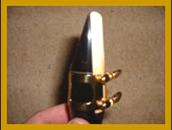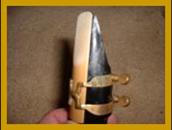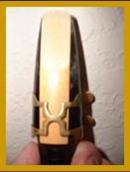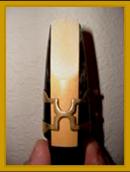

|
SaxophoneMan.com |

|
All Things Saxophone |
|
Equipment Fundamentals — Ligatures |
|
Last modified 09/12/08
|
|
Questions or comments? Send us an email |

|
What's a ligature? This is what my beginning students almost always ask me within their first lesson or two. The dictionary defines ligature as follows: lig- a-ture [lig-uh-cher, -choor] anything that serves for binding or tying up, as a band, bandage, or cord. I couldn't have said it better. A ligature exists solely for the purpose of holding the reed on the mouthpiece! Its existence is a catch-22. It would be great if the reed could stay on the mouthpiece by itself, because then the reed could vibrate more freely and produce a bigger sound! In fact, a lot of players (including myself) get a better sound when they bind the reed on with a rubber band. Try it — you’ll be surprised. The problem you will encounter (duh) is the reed slips and slides every which-way. So, even though a ligature dampens the sound, it is a necessary item. Having said that, it is CRITICAL that the ligature is properly fitted and placed on the mouthpiece. There are three placement points to consider: · Proper size/fit of ligature to mouthpiece I think it goes without saying that for an Alto sax mouthpiece you need an Alto Sax ligature, and for Tenor, Bari etc. the corresponding ligature. However, even ligatures made for Alto (or Tenor, etc.) are still often made for a specific mouthpiece -- there are very few "one size fits all" ligatures and most of them are junk. Manufacturers are always experimenting with new designs that limit the contact surface with the mouthpiece and reed but still hold the reed in place. Usually a manufacturer makes a ligature to fit a particular line of mouthpieces. Make sure the ligature you are using is designed for your mouthpiece. · Placement of the screws (front or back) Some ligatures are designed to have the screws on the back of the mouthpiece, and some are designed to have the screws on the front of the mouthpiece -- over the reed. Be certain of the proper screw placement for your ligature, and don’t over tighten the screws — just snug is fine.
Front placed screws Rear placed screws · Placement of the ligature in relation to the shaft of the mouthpiece and reed This is one that I find a lot of students aren't aware of when they first come to me. The reed needs freedom to vibrate. If the ligature is high up on the face of the reed then the reed is "choked" and can't vibrate like it should. Place the ligature as low as possible on the shaft of the reed without falling of the shaft of the mouthpiece.
Too low Too high Just right Another parameter that the manufacturers experiment with is the material the ligature is made of. Most are copper/nickel (brass) alloy but some include silver or gold plate and some have bands made of rubberized canvas or leather. I have even seen some players use a leather shoe lace to attach the reed. It works! · Taking care of your ligature A ligature is delicate piece of equipment -- take care of it. Broken screws can probably be replaced, but if you happen to bend the band (or tear it if it's canvas/leather), then the ligature is toast. Seek out professional repair and if you're lucky they can fix it, otherwise you will have to get a new one. In the end your ligature selection will be based mostly on what works best for you personally -- try several manufacturers, keeping the above criteria in mind and you will find one that is suited for you and your saxophone. |




